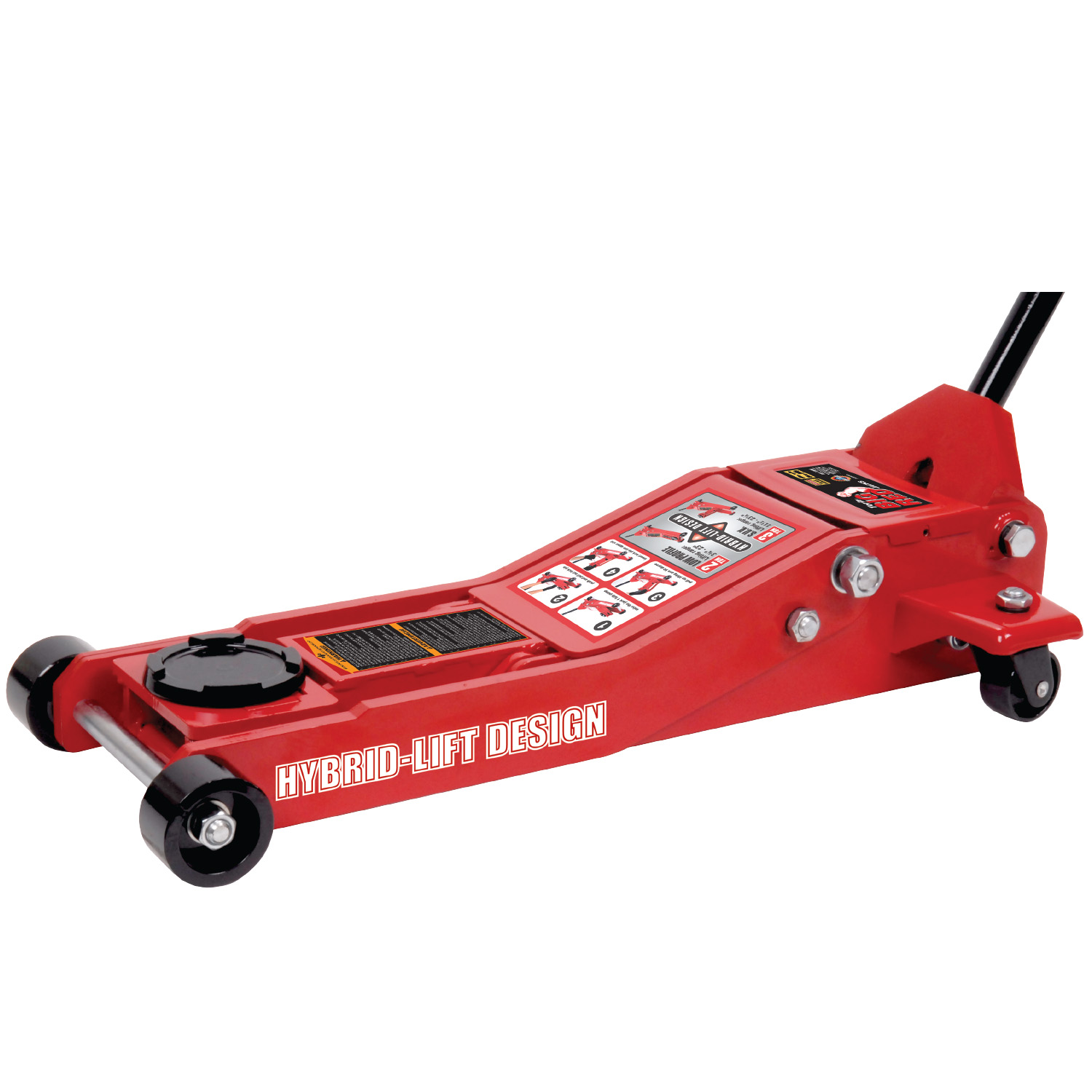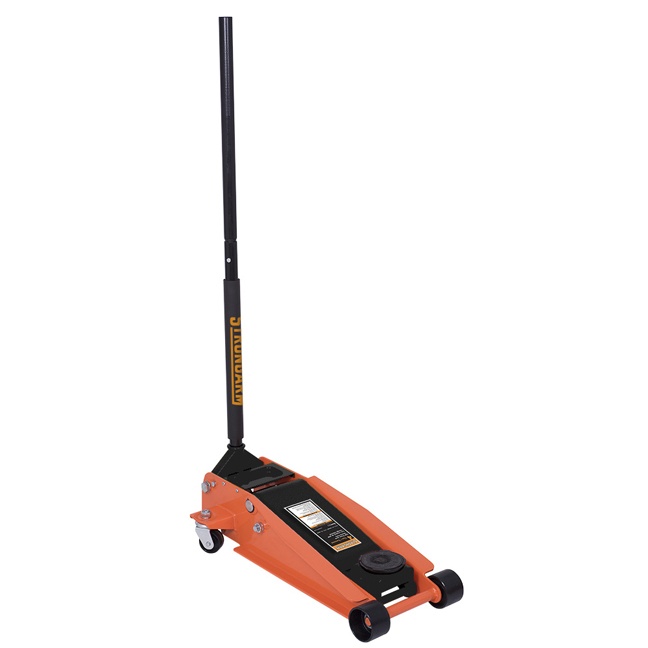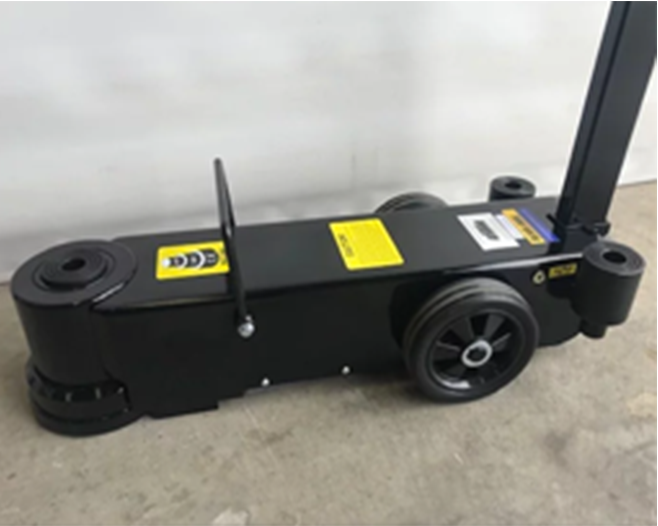Browse the Toolstation range of car lifting equipment including jacks, stands and winches for the professional mechanic. Choose a bottle jack to lift vehicles safely such as the bottle jack 2000kg with a lifting saddle and carry case or SIP bottle jack to lift up to 4 tons. The hydraulic trolley jack is essential for stable vehicle lifting, with a robust swivel saddle and holding capacity of up to 2 tonnes. Kit out your workshop with tools to lift and move heavy equipment with ease.
Find an electric hoist to lift vehicles securely such as the electric hoist with a lifting capacity of up to 250kg and a cable length of 12m. Find winches such as the pull winch that can pull up to 400kg with an aircraft steel cable and steel frame. Keep objects raised with a pair of secure axle stands that can take loads of up to 6000kg and a maximum height of 420mm.
Spend over £25 online and receive free delivery or click and collect from your nearest Toolstation branch. A hydraulic jack operates differently and will raise the vehicle more quickly, but it will require more space. To lift the car with a hydraulic floor jack, pump the long handle up and down until you've reached the required height.
It should only take between three and 10 pumps depending on the jack used. Lifting the tire a few inches off the ground is sufficient to remove the wheel and change a flat or check the brakes or suspension. Both types of car jacks come in many shapes and sizes to lift small cars, heavier large cars, and higher-riding trucks and SUVs. If you're going to purchase a car jack, make sure you get one with the proper weight capacity to lift your vehicle safely.
Prices range from about $15 for the lightest duty scissor jack that can lift one ton, to about $800 for a high-capacity, three-ton hydraulic unit made of lightweight aluminum. But you don't have to spend that much to get a high-quality hydraulic floor jack—many are available for less than $100. If money's tight and you need a floor jack, grab ahold of this Pro-Lift unit. Priced at just $36, it's small, it's lightweight and, believe it or not, it's mighty, too.
This car jack has a lift capacity of 1.5 tons and is made of welded steel. Its maximum lift height is a modest 12 inches, but it only weighs 18 pounds, so don't expect it to be able to raise mountains. Underscoring this product's inherent goodness, it has a 4.3-star rating after nearly 1,900 customer reviews. For both amateur and professional mechanics, a method of lifting vehicles is required to perform many maintenance tasks safely and efficiently. The pros often have massive hydraulic hoists that come with equally massive price tags.
At the consumer level, however, there are also quite a few practical options for jacking up a car, including a floor jack, scissor lift, bottle jack, or just simple ramps. Here, we will explain the different types of jacks, their variety of uses, and which ones you may want to purchase for your own garage. A jack is a mechanical lifting device used to apply great forces or lift heavy loads.
A mechanical jack employs a screw thread for lifting heavy equipment. The most common form is a car jack, floor jack or garage jack, which lifts vehicles so that maintenance can be performed. Jacks are usually rated for a maximum lifting capacity (for example, 1.5 tons or 3 tons). Gravity keeps your car or truck firmly planted on the pavement. Cars weigh 900 kg to 1,500 kg (2,000 lb. to 3,000 lb.) and some trucks and SUVs weigh up to 3,000 kg (6,000 lb.). How do you choose the right car jack for you and your vehicle?
When it comes to car lifting, there are several types of jacks available, such as the scissor jack, floor jack, Z-jack, screw jack, bottle jack, and farm jack. The Husky 2-Ton Hydraulic Trolley Floor Jack is great for use on smaller vehicles. It will lift up to 2-Ton (4,000 lbs.) with minimum lifting height of 5 in.
The removable handle and the carrying handle on the 2-ton hydraulic trolley jack makes it easy for storage. This car jack is the perfect car accessory to add to your Husky automotive and tool collection. Floor jacks are another type of hydraulic car jack that uses the same working principle as bottle jacks.
In a bottle jack, all the force is translated vertically, however in a floor jack, the lever pushes fluid to turn an arm upwards, and the force gets translated from horizontal to vertical. The arm has a saddle on its end that connects to your car's lifting point and sits comfortably within the body of the floor jack when not extended. Hence, the floor jack is closer to the ground, great for cars with a low profile. Support the front of a truck by placing the jack stands directly under the frame.
Support the rear of the truck with a jack stand under each axle. Turn the handle very slowly until the vehicle starts easing down. A quick release will result in a sudden catastrophic drop. Lower the car or truck until it almost touches the saddle of the jack stand. Then make final alignment adjustments before lowering the full weight onto the stand. Remove the floor jack and bring it to the rear of the vehicle.
Locate the recommended rear lift point and repeat the jacking procedure at the rear of the vehicle. Place the two rear jack stands in proper support locations and lower the rear onto those stands. If you're looking for a mix between capability and value, look no further than the ABN three-ton electric hydraulic jack. With a weight capacity of 6,000 pounds, it's safe to say you'll easily be able to lift most sedans and SUVs. This electric car jack has a built-in safety device to hold the weight of your car steadily, even when it's not powered. You won't have to worry about your car suddenly slamming back down on the ground.
Wheel-mounted floor jacks use a hydraulic cylinder to lift a hinged section of the jack, which in turn lifts part of the car. They have largely replaced old-school "bottle jacks" where the hydraulic cylinder directly lifted the car, as bottle jacks rarely fit beneath modern passenger cars. Bottle jacks still can, however, be a cost-effective choice on trucks. As such, it is essential to have jack stands on which the vehicle can be safely set down for work underneath. Significantly more affordable than the previous steel floor jack highlighted here is this Pittsburgh unit.
Treated to a fetching red paintjob and made of sturdy welded steel, it has a 3-ton (6,000-pound) lifting capacity. Weighing in at around 75 pounds, it's a solid piece of work, though its wide casters should help improve both maneuverability and, more importantly, stability. A rapid-pump mechanism gets this jack up in no time flat, while its low-profile design means it should fit under a wide range of vehicles. Overall, this is a nice car jack for a reasonable price of $120. Car mechanic putting hydraulic jack under the car for repairing in auto repair service. An image of a red car jack on the floor beside a toolbox.
If you want a high-quality, long-lasting, super-versatile floor jack, consider this premium, heavy-duty Torin unit. It can support up to 3 tons , features a 20-inch lifting height and comes with a two-year manufacturer warranty. A quick-lift pump design gets the business end up to the vehicle you're lifting much faster so you're not sitting there pumping the handle going seemingly nowhere. This low profile floor jack should easily slide under even aggressively dropped vehicles, plus its near 67-pound weight and heavy-duty steel construction means it's built to last. Consult your owner's manual to be certain, but nearly every modern car has jacking points with plastic pads near the inboard fender corners for each wheel. If your owner's manual doesn't show them in sufficient detail, search online for a good photograph.
If the lifting saddle of your floor jack does not have an integrated rubber pad, be certain to put one there , and that it is touching the jack point andonlythe jack point. The last thing you want to do is pinch a brake or fuel line or tear a hole in the floor. To set a car on jack stands for repair work, however, you need to lift it by a central point on the front or rearsubframeinstead. To reach those points on a low car, you may need a low-profile, long-reach jack.
This right here, folks, is a serious floor jack, a top-quality, professional-grade jack. At $887 it is far,farfrom cheap, but for dealerships and repair shops, it's tough to top. Built by OTC, a world-renowned company, this air-assisted hydraulic jack is a real honey and loaded with plenty of premium features.
Actually, it's better than that; it's the Rolls-Royce of car jacks. And at a husky 196 pounds, it should be nigh on indestructible. The purpose of a car jack is lifting the car and maintaining it at a certain height during different repairs. This paper focuses on the design of car jack, which belongs to the basic equipment of cars.
Cars jacks are used mainly for changing tires and small repairs of a car. The aim of this paper was to create a parametric CAD model of a car jack and carry out numerical structural analysis of the car jack using the created parametric CAD model. The development of the parametric CAD model and structural analysis was performed using the CATIA V5 system.
This paper describes the modern way of creating more complex mechanisms, which support quick modification of its parameters, and thus the entire design. The stresses obtained by finite element method analysis were confirmed with the analytical calculation in characteristic parts of the design, with some exceptions. At the end of the paper, an analysis of the obtained results was performed, on the basis of which specified conclusions were made. Electric car jacks that are portable weigh less and take up less space. An ideal weight for an electric car jack would be anything less than the weight of your spare tire.
That way, you can easily handle the car jack during use without tiring your muscles before you even get started on the hard work. Electric car jacks relieve the physical strain of cranking a manual jack and shorten the overall repair time dramatically. If it's time to invest in a new model that will do the job right and get you home safe, check out the electric car jack as an option. No matter what skill level you have when it comes to vehicle maintenance, having an automatic electric car jack can be handy to have around. As part of a basic set of automotive tools, the power car jack can be used on most cars, boats, trailers, and off-road vehicles. Almost 100 years later, using a car jack can still be intimidating as well as dangerous.
But with the proper safety precautions and procedures, as well as plenty of common sense, you can lift your vehicle and change that tire without hurting yourself or damaging your vehicle. Here we'll cover the different types of car jacks available, and we've included many important safety tips as well as the proper techniques for correct lifting and lowering. Alwaysset the car down on properly-rated jack stands before putting any part of your body under it. Many people will change wheels with a car only supported by a jack, but small inclines and soft asphalt can make a car topple off a jack.
It is always safer to set the car on stands, and leave the floor jack in place as a backup. The best solution for lifting the car is a hydraulic scissors jack, one type of car lift, that slides under the car and lifts the car and all four wheels. If you're going to do work on a car more involved than washing it or tossing out Starbucks cups, you're going to need a floor jack.
Even if you're just changing a flat tire or swapping winter wheels for summer ones, you want something that's safe and quick. The Husky 3-Ton Jack Stand pair is designed to lift up to 6,000 lbs with a heavy-duty steel base with anti-sink feet for added durability and safety. This pair of jack stands have an extension range from 12 in. And are equipped with a locking pin for added safety.
This jack stand car accessory can be used with an SUV, light truck and standard automobiles. The Husky 3-Ton Jack Stand pair works with any Husky automotive floor jack, found at the Home Depot. Bottle jacks have a small form factor, enabling you to store them easily. They also have a higher lifting capacity than scissor jacks, up to 50 tons, but for most cases, a 2 ton rated one should suffice. 2 ton (4000 lbs.) jacks are relatively inexpensive and can lift most sedans and SUVs, an ideal car jack to have around the house for home repairs. After choosing the best car jack, always practice safe lifting technique.
Set the parking brake and chock the wheels opposite the lift. Always set the car down on jack stands before beginning work on your vehicle. Once your vehicle is ready to be worked on, check out our guide to choosing a mechanic's tool set. If you own an older car and don't have a 12-volt power outlet, this is perhaps not a smart purchase to make either. There are a lot of great features to consider on this electric car jack.
For example, having a height-adjustable jack allows you to raise the car high enough to safely remove a flat tire. A quick extension time means you won't be waiting in the weather, so you'll be able to get the job done faster. The electric car jack is also constructed of high-strength steel, so you can feel safer working underneath the car with it holding the weight. Having a car jack in your vehicle in case of an emergency can mean the difference between 20 minutes to change a flat tire and being stranded on the road for hours, waiting for help.
For instance, a floor jack can work great for lifting a car, but a semi-truck needs a bottle jack. And why invest in a floor jack when a cheap steel scissor jack works just fine? There is a method to the madness, and often, it has to do with preference and convenience, but sometimes, it is all about safety. Never climb underneath a car or truck when it's supported only by a car jack.
The jack can easily slip out from under the vehicle or fail, bringing thousands of pounds of weight down on top of you without warning. If you're going to crawl under the vehicle, first purchase a high-quality set of jack stands. Do not use boxes, cinder blocks, or bricks as a makeshift substitute. The mechanism used by a scissor jack is simple and easy to use, making it a reliable option for many cases. However, a scissor jack is not meant for everyday maintenance and is more of an option provided by car manufacturers in cases of emergency, like changing a flat tire when on the road.




























No comments:
Post a Comment
Note: Only a member of this blog may post a comment.